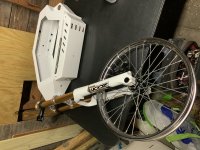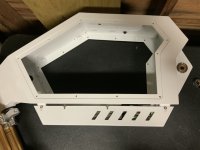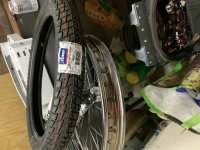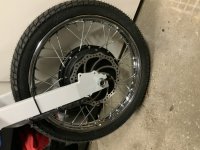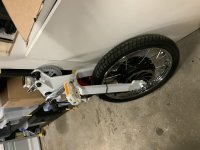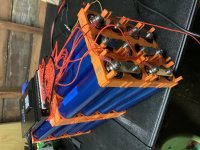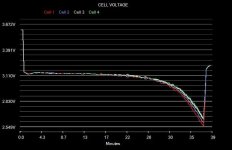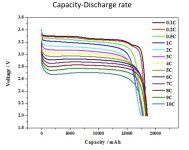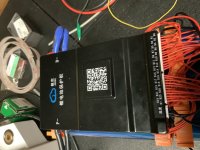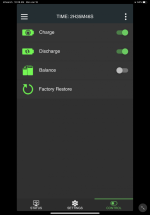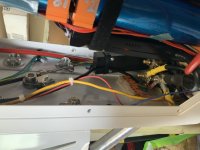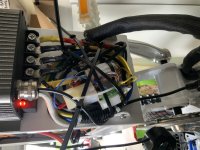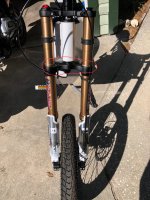Sometimes progress is slow. As previously mentioned, the first priority for "fixing", was the anemic performance of regeneration as a substitute for the rear braking performance. I knew from "manual" testing, by spinning the wheel in the air, and applying maximum travel of the cable actuated throttle, more braking was available. However, my arrangement of using an ordinary brake cable and brake lever, to pull the linear throttle was only using about 1/2 of the available travel.
So first, I went to the Sabvoton controller configuration to try and make adjustments. While you can program the "regular" throttle voltages to scale acceleration/speed to match the output voltages available, there are no such parameters for the Hall effect or pot sensor used for variable regen. So I went in and tried to increase the regeneration current limits to approximately 2X what I really wanted. It did help some, but before I was satisfied, variable regen stopped working entirely. WTF. No matter how I configured things, even manually back to "standard" levels, variable regen seemed permanently "OFF".
So I did the only thing left I could think of, and reset the controller to factory settings. Then disaster struck. Not thinking that through fully, when I applied power to the throttle on the test stand, the wheel went backwards, and with backwards, so the pedals went flying too, grabbed the USB cable, jerked it out of the PC and the motor controller connection and whipped it around like a slingshot hitting the concrete floor of the garage several times:

I reconnected the wires, but the unit was dead. Damn. Am I gonna have to wait for a replacement from China? I used the Bluetooth dongle to get the wheel spinning the right direction again (this install is a "1", not the default of "0"). However, as previously mentioned, the USB cable and PC program is required to configure variable regen.
Saved by this forum, a different, historical thread suggested using a USB to TTL driver board that had the same chipset. The link to the eBay part was dead, but I found something similar on Amazon:

$8 for five boards. Would that work? Yep and it's really an improvement. The factory cable connects the USB power from the computer to the Sabvoton, so even if the ignition is OFF, the Sabvoton processor board remains "ON" while the cable is connected. I suppose in a factory, this would be convenient so you could program a controller out of the box with no other connections. But in this setting, testing a build with a 72V battery connected, and iteratively powering the motor, that connection is of dubious value, and if anything, might be a path for frying your computer. I posted the Amazon link on the old thread.
Back to work!
After the reset, variable regen was in fact working once again! Things were looking up. I came to the conclusion I needed more travel on the brake cable that pulls the linear throttle for variable regen. Or I was going to have to kill the brake lever idea, and use a thumb throttle like I did on my first build using a Phaserunner.
So how do you double the travel distance of the brake cable? The first thing I found was a device called a "travel agent".

It's designed for V brakes using short travel brake levers. The inline version was discontinued several years ago, but one that mounts to a V brake still around. This device uses two pulleys, one small and the other large to double the travel length of a brake cable. Sounded like just what I needed. Scored a set off eBay, but just didn't have a way to mount it short of completely rebuilding it and welding a mounting bracket. I needed the inline version.

None available. And for the record, this device designed for turning 5mm pull into 10mm, might be insufficient. I had about 10mm, but needed 20mm. No other device I could find even uses this principle of a double pulley to scale wire or rope travel. There is this one that uses different lever lengths:

But that doesn't seem to be the 2:1 ratio needed. I do think this would be easier to build. Some aluminum plate cut to requirements swiveling on a bolt. The in and the out don't have to be in the same place providing flexibility.
Then I thought of a block and tackle. But in reverse. At first I thought space was an issue, and it would require multiple pulleys. Finally when I realized the linear throttle had more cable that extended with actuation and I found a micro sized pulley I came up with this design (shown close to scale):

It's almost exactly doubles the pull. Only one pulley, and easy to implement. Off to West Marine, who happened to have these at 2 for $12, a little work on the eBike and I have this pull arrangement now:

The geometry isn't perfect. Not 100% satisfied yet. However, it works. The brake lever now gets full travel of the actuator, a couple turns on the brake adjustment screw bottoms out the pull length.
A very short test ride before the Super Bowl demonstrated sufficient rear braking. First impression is it's equal to the front brake in effectiveness. Time for a longer test ride to check this out a bit further and to test out some additional Sabvoton parameters. Figure I will get that optimized in pass-thru mode before going on to fine tune the CA3 parameters. This motor does have some kick...during the short test ride I had the front wheel unexpectedly leave the ground on full acceleration from about 5 mph.


